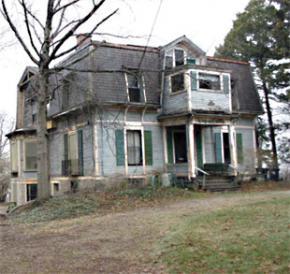August 8, 2013
 Grampian Way house in distress: Home has many historic links, but is not a designated landmark— yet. Photo courtesy City of BostonThe building, its grandeur as the Kehew-Wright House long faded into the mists of time, is today a model of decrepitude perched atop Savin Hill at 24 Grampian Way.
Grampian Way house in distress: Home has many historic links, but is not a designated landmark— yet. Photo courtesy City of BostonThe building, its grandeur as the Kehew-Wright House long faded into the mists of time, is today a model of decrepitude perched atop Savin Hill at 24 Grampian Way.
But the Boston Landmarks Commission is looking past the wreck of its remains to its history as long a place of import in the neighborhood and the city and recommending that the house, which sits on almost three-quarters of an acre accompanied by a dreary-looking one-time stable building, be given a landmark designation.
To that end, the commission will hold a public hearing for consideration of its recommendation next Tuesday, Aug. 13, at 5:45 p.m. in the Boston Redevelopment Authority boardroom, Room 900, in Boston City Hall.
Built in the early 1870s as a single-family, the property, currently unoccupied, has had five proprietors, and is owned today by the last of the five, the family of the late Raymond Tomasini, who purchased the house in 1951 and raised his family there. The Landmark Commission’s study report notes that the property has a total assessed value of $395,190, with the land valued at $278,190 and the building at $117,000.
The report backs the commission’s proposal by citing the house as “notable for several historical and architectural qualities: as an early example of the fashionable, late 19th century suburban development of Savin Hill, retaining its relatively large lot and early stable; for the fanciful, Stick Style influence on the design of both structures; and for its associations with several prominent figures of the late 19th and early 20th centuries, in a wide range of fields: William Prescott Hunt, a wealthy industrialist; John Kehew, a maker of nautical instruments and an oil merchant; and George Wright, an early baseball celebrity, sporting goods businessman, and sports promoter for whom the municipal golf course in Hyde Park is named.
A story in the Dorchester Reporter in October 2009 noted the beginnings of an effort by Savin Hill residents to come to grips with what a next-door neighbor, Peter McNamara, called “a sore spot in the neighborhood.” At the time, McNamara said several area residents had joined his effort to first gain landmark status, and then maybe undertake a restoration of the once-glamorous property. The Tomasini family, meanwhile, was working through Raymond Tomasini’s death in 2007 and had no plans then to do anything with the house and property.
The Landmarks panel’s report notes that “a representative of the owners has been in touch with” the commission and “has expressed concern about the impact of Landmarks designation on their ability to sell or otherwise modify the property.”
The commission notes that a Landmark Designation “represents the city’s highest honor and is therefore restricted to cultural resources of outstanding architectural and/or historical significance.” A designation “would require review of physical changes to specified exterior features of the property, in accordance with the standards and criteria adopted as part of the designation.”
In addition, a Landmark designation results in listing on the State Register of Historic Places. “Without it, the city would be unable to offer protection to exterior features, or to extend guidance to the owners” under the law.


